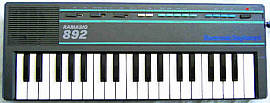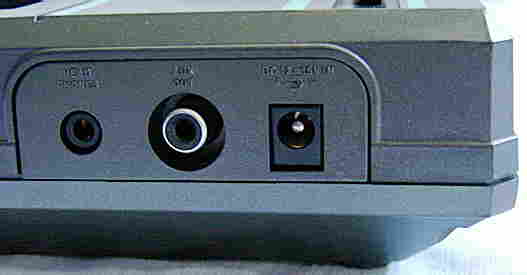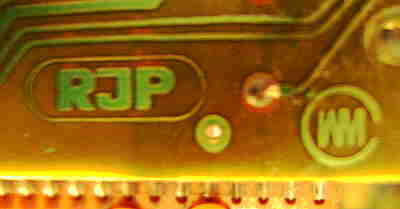|
|
You certainly know keyboards from Casio, but did you ever hear
a Ramasio?
 The blue writing "electronic keyboard" was retouched; in reality it was
almost invisible on the photo.
The blue writing "electronic keyboard" was retouched; in reality it was
almost invisible on the photo. |
This bizarre and great sounding keyboard is technically something extremely unique, because on the one hand it is a small midsize instrument with COB (black blob) CPU for the main voice, while on the other hand it is full polyphonic with monophonic piano envelope - a technology that normally was already abandoned in the beginning of 1980th.
The sound of the Ramasio 892 is made from sonorous mixed squarewaves with a nice warm and bassy analogue timbres. Also the percussion is analogue with transistor noise and sound quite unique like the rest of the instrument. Interesting is the unusual full polyphonic fingered chord accompaniment, which permits various play tricks and responds so rapidly that it even accepts trilled notes and not only plays non- chords but even weird grunting cluster patterns. Unlike the simple accompaniment of Antonelli Star 2379, this one even includes walking bass patterns and can do single finger chords.
(Note: This keyboard sounds great, but don't buy one of these so far your only intention is to get a keyboard with faithfully imitated natural instrument sounds. Remember, this is a squarewave keyboard those timbres sound not remotely like what is written on its switches, though bought with wrong expectation it may disappoint you. Also the monophonic envelope behaves very different from normal polyphonic keyboards.)
This instrument was also released as an unbranded version (no type label on case; here named RJP 892).
 |
 |
caution: The rubber contacts under the keys are not silicone and can decompose by things like ozone, UV light, oil or battery leak vapours. For protection store this instrument without battery in an airtight PE or PP plastic bag away from direct sunlight.
The main voice is made from 5(?) mixed squarewaves with monophonic volume envelope and sounds pleasantly warm and bassy. The timbres "organ" , "flute", "horn" use the same envelope (slow attack phase like a pipe organ, tones end with a click when released). "organ" resembles the famous sonorous multipulse pipe organ timbre, "flute" is plain squarewave, "horn" is a duller muffled multipulse timbre. The "piano" sounds not remotely like expected; it is simply the "organ" timbre with additional monophonic envelope that fades quieter, but unlike a real piano it has a way too slow attack rate (like "organ"), fades quieter too slow and even never reaches silence but stays on at low volume, thus with held notes it basically it sounds like short pipe organ notes with much sustain. After key release it immediately ends with a quiet click. Due to the envelope is monophonic, the tones of all currently held keys sound again at full volume as soon a new key is pressed. All timbres contain a weak and fast vibrato that can not be switched off, and the internal vibrato trigger pulses crosstalk as a quiet fast ticking in all sounds (particularly strong during decay phase of the "piano"). There is no sustain switch. The multipulse-like waveforms are genuinely made by mixing tones of different octaves; by setting the preset sound slider into intermediate positions between "organ" and "flute" or "flute" and "horn", 2 additional such timbres come into being those are mixed from the 2 adjacent ones.
The analogue percussion sounds quite unique. While hihat and snare are made from transistor noise, the base is quite dull and sounds like knocking on cardboard or the like. The special sound is the snap, which is a high, thin and rather loud percussive bang, that resembles finger snapping or a tiny exploding firecracker. I don't know if the manufacturer intended it do be a clave, but it doesn't sound at all like one. All rhythms contain a fast quiet ticking, that is likely the vibrato trigger pulse mixing itself into the transistor noise sound. The tempo slider can be set very slow but not really fast (unless you modify it - touching the sound IC (clock pin?) increases tempo to tremendous speed).
The accompaniment always starts the rhythm, thus there is no manual
chord mode, but otherwise it is greatly versatile playable and sounds unique.
The automatic accompaniment patterns consist of a bass line (playing the
leftmost and rightmost of the currently held accompaniment keys) and a
polyphonic piano chord (with the notes of all held accompaniment keys).
Both employ a capacitor envelope for decay. With the "bass" button the
bass line can be switched to a more complex walking bass pattern. Great
is that the accompaniment itself does not hold any notes, thus it responds
so rapidly that it even accepts trilled notes, and instead of a chord you
can play even any weird disharmonic note clusters those get also gated
by the accompaniment into a wildly grunting sound. Like a Hammond
organ, the accompaniment notes start and end with a noticeable quite click
during all key presses. Also the accompaniment patterns are partly unusual
and contain strange fluttering dual note trills. When accompaniment is
started by pressing the chord "on" button and chord "memory" is not active,
the rhythm with accompaniment plays only so long any key in the accompaniment
section is held down. It stops by releasing these keys and always restarts
the pattern by pressing an accompaniment key. This way some weird breakbeat
stuff can be played by trilling on the keys. When rhythm instead was started
with rhythm "start/ stop" or "synchro", the rhythm stays on with keys released.
When "memory" is pressed, also the accompaniment continues with its keys
released. The "auto / manual" button enables the single finger chord mode
(accepts only minor and major chords?).
hardware detailsThe Ramasio 892 is based on the COB CPU "5851-541, 260D6" with separate drawbar sound IC "TMS3630NS".
 On
the main PCB is a logo "RJP", which is a company that in 1970th
made LED pocket calculators and apparently later only toy keyboards. E.g.
they made the "MU-781 Sound Mix Organ Karaoke" (with cassette recorder
and effect sounds like Bontempi -
Disney Band, I own one), the RJP
MU-7986 and the "RJP 896 Programmable Guitar Organ" (grey
case resembling Yamaha SHS-10,
seen on eBay). On
the main PCB is a logo "RJP", which is a company that in 1970th
made LED pocket calculators and apparently later only toy keyboards. E.g.
they made the "MU-781 Sound Mix Organ Karaoke" (with cassette recorder
and effect sounds like Bontempi -
Disney Band, I own one), the RJP
MU-7986 and the "RJP 896 Programmable Guitar Organ" (grey
case resembling Yamaha SHS-10,
seen on eBay).
The CPU has only 23 pins although there are 37 keys connected to it
and there are no additional logic ICs.
drawbar synthesis Traktor told me that the preset sound switch uses 3 contacts
to mix 3 drawbar tones from the sound IC through different resistor combinations.
Thus certainly potentiometers can be installed here for real drawbars.
The accompaniment data seem to be multiplexed with percussion trigger outs. (I haven't analyzed the hardware further yet.) |
The Ramasio 892 unfortunately is extremely rare; I only saw one other specimen yet, however I was told by e-mail that the RJP 993 (grey with yellow buttons, same preset sound & rhythm names) apparently had the same hardware. And Traktor told me that apparently a Danish variant by Star Mate with different case and mainboard (206D15 instead of 206D5) exists. A predecessor of the 892 was the Kamosonic KB-1000 (49 midsize keys, no envelope, no accompaniment (only manual organ chord keysplit)). A far relative of the 892 may be the midsize Jiaying Z4941. Another analogue keyboard with full polyphonic accompaniment was the way oversized Antonelli Star 2379. Also Antonelli 2495 permits similar play tricks. The strange monophonic main voice envelope exists also e.g. on Bontempi Minstrel Beta.
Question: Does anybody know other
non-toy keyboards made by Ramasio or RJP?
| removal of these screws voids warranty... | ||
 |
||
|
|